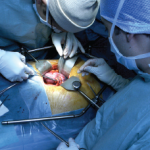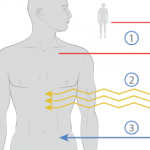CHICAGO—Medications have frequently been implicated as a cause of musculoskeletal complaints, including persistent arthralgias, arthritis and myalgias.1 The list of offending agents is diverse, and the degree of symptoms is variable. In the world of transplant recipients, this list is exhaustive and includes immunosuppressive agents (cyclosporine, tacrolimus); myeloid growth factors, such as G-CSF; antibiotics (quinolones); and antifungal drugs (voriconazole).
Additional etiologies for musculoskeletal complaints may include hyperuricemia and gouty arthritis, osteoporosis, aseptic necrosis of the femoral head and septic arthritis.
Calcineurin inhibitor pain syndrome (CIPS) is a rare syndrome, characterized by symmetric lower extremity arthralgias and long bone pain, seen among patients currently on treatment with calcineurin inhibitors.
Below, we discuss the case of a patient who presented with bilateral symmetric knee pain while on cyclosporine. Our case highlights the importance of keeping CIPS on the differential diagnosis when a transplant recipient presents with arthralgias and bone pain. It also elucidates the challenges of treating this entity.
Case Report
A 53-year-old man who had received a liver transplant for a diagnosis of alcoholic cirrhosis was referred to the rheumatology clinic for unremitting knee and lower extremity pain, fatigue and myalgias.
Approximately one month after his transplant, he complained of polyarthralgia, predominantly affecting the large joints (shoulders, knees, back and ankles), for which he had been treated with prednisone. Consequently, most of his arthralgias resolved, except for persistent knee pain.
He was then evaluated at his primary care physician’s office, where a physical examination revealed bilateral crepitus in his knees. Knee X-rays showed evidence of bilateral, medial joint space narrowing (see Figures 1 and 2). An initial diagnosis of osteoarthritis was made, and he was referred to physical therapy for quadriceps strengthening.
Within six months, however, the patient’s pain had significantly worsened. He couldn’t walk without assistance and, consequently, needed crutches. At this time, about a year after his transplant, he was referred to the rheumatology clinic.
In the clinic, the patient described intense, constant pain, primarily in both knees, but also affecting his legs. This was constant, disabling and present throughout the day, without a morning predilection. His past medical history was significant for hypothyroidism, hypertension and gastroesophageal reflux disease. He was on several medications, including cyclosporine for immunosuppression and acetaminophen, which he used as an analgesic.
The musculoskeletal exam was notable for bilateral quadriceps atrophy, crepitus in the knees and small, bilateral knee effusions. The rest of his physical examination proved unremarkable.
The initial laboratory workup revealed mild anemia (hemoglobin 11.4 g/dL), an elevated sedimentation rate (64 mm/hr) and an elevated alkaline phosphatase (ALP) level (261 U/L). Because his other markers of liver function were normal, a bone-specific alkaline phosphatase was checked, which returned elevated (30 µg/L). The remainder of his labs were unremarkable.

